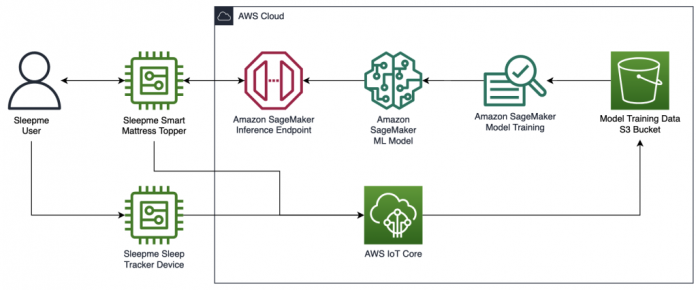This is a guest post co-written with Trey Robinson, CTO at Sleepme Inc.
Sleepme is an industry leader in sleep temperature management and monitoring products, including an Internet of Things (IoT) enabled sleep tracking sensor suite equipped with heart rate, respiration rate, bed and ambient temperature, humidity, and pressure sensors.
Sleepme offers a smart mattress topper system that can be scheduled to cool or heat your bed using the companion application. The system can be paired with a sleep tracker that gathers insights such as heart rate, respiration rate, humidity in the room, wake up times, and when the user was in and out of bed. At the end of a given sleep session, it will aggregate sleep tracker insights, along with sleep stage data, to produce a sleep quality score.
This smart mattress topper works like a thermostat for your bed and gives customers control of their sleep climate. Sleepme products help you cool your body temperature, which is linked with falling into a deep sleep, while being hot can reduce the likelihood of falling and staying asleep.
In this post, we share how Sleepme used Amazon SageMaker to developed a machine learning (ML) model proof of concept that recommends temperatures to maximize your sleep score.
“The adoption of AI opens new avenues to improve customers’ sleeping experience. These changes will be implemented in the Sleepme product line, allowing the client to leverage the technical and marketing value of the new features during deployment.”
– Trey Robinson, Chief Technology Officer of Sleepme.
Using ML to improve sleep in real time
Sleepme is a science-driven organization that uses scientific studies, international journals, and cutting-edge research to bring customers the latest in sleep health and wellness. Sleepme provides sleep science information on their website.
Sleepme discusses how only 44% of Americans report a restful night’s sleep almost every night, and that 35% of adults sleep less than 7 hours per night. Getting a full night’s sleep helps you feel more energized and has proven benefits to your mind, weight, and heart. This represents a huge population of people with opportunities to improve their sleep and health.
Sleepme saw an opportunity to improve the sleep of their users by changing the user’s sleep environment during the night. By capturing environment data like temperature and humidity and connecting it with personalized user data like restlessness, heart rate, and sleep cycle, Sleepme determined they were able to change the user’s environment to optimize their rest. This use case demanded an ML model that served real-time inference.
Sleepme needed a highly available inference model that provides low-latency recommendations. With a focus on delivering new features and products for their customers, Sleepme needed an out-of-the-box solution that doesn’t require infrastructure management.
To address these challenges, Sleepme turned to Amazon SageMaker.
Using Amazon SageMaker to build an ML model for sleep temperature recommendations
SageMaker accelerates the deployment of ML workloads by simplifying the ML build process. It provides a set of ML capabilities that run on a managed infrastructure on AWS. This reduces the operational overhead and complexity associated with ML development.
Sleepme chose SageMaker because of the capabilities it provides in model training, endpoint deployment process, and infrastructure management. The following diagram illustrates their AWS architecture.
Sleepme is focused on delivering new products and features for their customers. They didn’t want to dedicate their resources to a lengthy ML model training process.
SageMaker’s Model Training allowed Sleepme to use their historical data to quickly develop a proprietary machine learning model. SageMaker Model Training provides dozens of built-in training algorithms and hundreds of pre-trained models, increasing Sleepme’s agility in model creation. By managing the underlying compute instances, SageMaker Model Training enabled Sleepme to focus on enhancing model performance.
This ML model needed to make sleep environment adjustments in real time. To achieve this, Sleepme used a SageMaker Real-time inference to manage the hosting of their model. This endpoint receives data from Sleepme’s smart mattress topper and sleep tracker to make a temperature recommendation for the user’s sleep in real time. Additionally, with the option for automatic scaling of models, SageMaker inference offered Sleepme the option to add or remove instances to meet demand.
SageMaker also provides Sleepme with useful features as their workload evolves. They could use shadow tests to evaluate model performance of new versions before they are deployed to customers, SakeMaker Model Registry to manage model versions and automate model deployment, and SageMaker Model Monitoring to monitor the quality of their model in production. These features provide Sleepme with the opportunity to take their ML use cases to next level, without developing new capabilities on their own.
Conclusion
With Amazon SageMaker, Sleepme was able to build and deploy a custom ML model in a matter of weeks that identifies the recommended temperature adjustment, which the Sleepme devices mirror to the user’s environment.
Sleepme IoT devices capture sleep data and can now make adjustments to a customer’s bed in minutes. This capability proved to be a business differentiator. Now, users sleep can be optimized to provide a higher-quality sleep in real time.
To learn more about how you can quickly build ML models, refer to the Train Models or get started on the SageMaker Console.
About the Authors
Trey Robinson has been a mobile and IoT-focused software engineer leading teams as the CTO of Sleepme Inc and Director of Engineering at Passport Inc. He has worked on dozens of mobile apps, backends, and IoT projects over the years. Before moving to Charlotte, NC, Trey grew up in Ninety Six, South Carolina, and studied Computer Science at Clemson University.
Benon Boyadjian is a Solutions Architect in the Private Equity group at Amazon Web Services. Benon works directly with Private Equity Firms and their portfolio companies, helping them leverage AWS to achieve business objectives and increase enterprise value.
Read MoreAWS Machine Learning Blog


